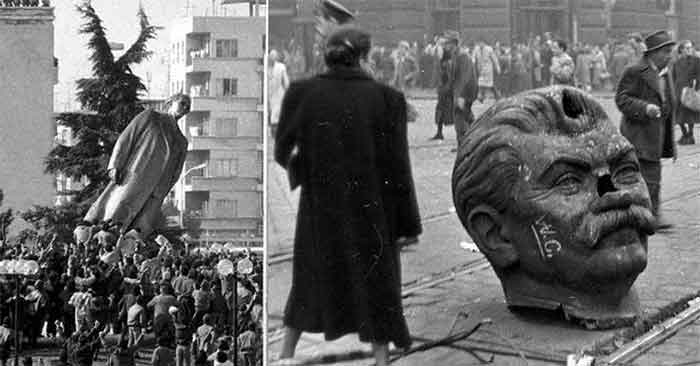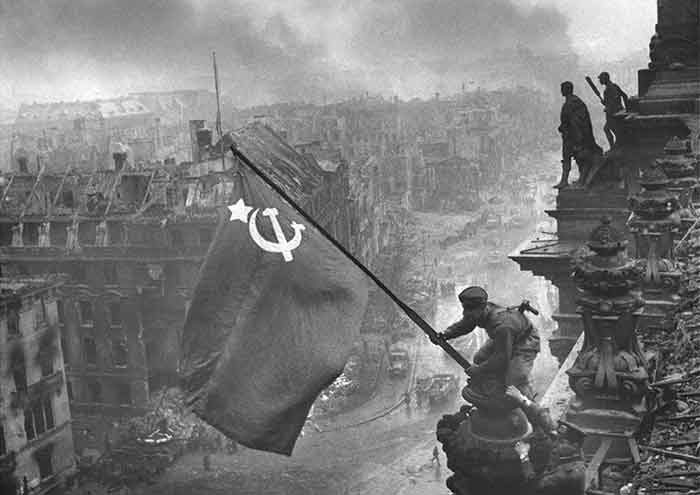
Today on December 30th we commemorate 100 years since the Union of Soviet Socialist Republics or USSR Was formed. Representatives of the Soviet governments of Russia, Ukraine, Belarus, and the Transcaucasian Republic (encompassing Armenia, Azerbaijan, and Georgia), declared the formation of a new country: the Union of Soviet Socialist Republics, the first nation in the world based on Marxist socialism.
“By the time the USSR turned 50, in 1972, it was recognized as a global superpower, matching or exceeding the military strength of its only rival, the United States,” says Benjamin Nathans, a history professor in the School of Arts & Sciences
This was an event of great historical significance which knit the seeds of the entire path breaking achievements of Soviet Union in Industry, agriculture, literacy, health, housing, employment, emancipation of women and winning the Great Patriotic War. Path was carved for establishing industrialisation and electrification, collectivisation and modernisation, the establishment of socialist production relations in the city and in the countryside. Scientific centralised economic planning, catered towards the needs of the people and the socialist construction and overpowered evils of capitalism. A path-breaking experiment and true manifestation of the democratic sprit of Leninism and Bolshevism.
It paved the way to adopting the most democratic constitution established ever till then in 1924.
It illustrated the Marxist and democratic approach to resolving question of merging nationalities into a nation. The formation was linked to the policies of a proletarian state formed in 1917 by the Bolsheviks, with Marxist method applied for the first time in history in integrating different states into a nation. Autonomy was given to the republics themselves, and not imposed from above. Marxist Scholars of history should all research into how proletarian power was linked with nationality question and truly democratic methods of establishing national unity.
Quoting Timor Zenker,of party of Labour of Austria “The founding of the Union of Soviet Socialist Republics on 30 December 1922 marked the greatest state-political achievement of the revolutionary working class to date. It was the result of the Great October Socialist Revolution of 1917, the successful struggle of the young Russian Soviet Republic against counterrevolution and interventions, the overcoming of civil war and so-called “war communism”.
Toppling of USSR
Tragically in December 1991 USSR fell. It had it’s roots in the Kruschevite overturning of Socialist policies after 1956.Still till 1991 many salient features of the USSR were preserved.
From 1990s, path was paved for breaking integrity of the Soviet State through separate existence due to the criminal actions of the authorities. As a result, the convenient shortest railway from Belgorod to Rostov-on-Don was changed because it entered the Kharkov region that had become “foreign”.
The whole capitalist world is decisively against the revival of the union of the former Russian state on any socio-political basis.
The large capital of the former union republics will immediately be exposed: by such a formation as Russian it is now Comprador, which banks on the reclaimed niches of the global capitalist market.
Lenin had elaborated deeply that unions of capitalist states are either lifeless or reactionary, with an objective of intensifying the power of capital and the exploitation of mercenary labor. Workers unity is destroyed by such unions.
We must recall after the destruction of the USSR, production in Russia slumped than 50% in the 1990s, and half of these losses were the result of the destruction of the country’s unified demographic complex. Even in the last three years, the disruption of economic ties between Russia and Ukraine has adversely y affected the aviation industry, rail transport, energy supply and many-many other economic sectors of both countries.
Vladimir Mayakovsky most aptly said: “The land with which you froze, you cannot fall in love forever.” And we, the Soviet people, together with the land of our great united country were not only freezing. We defended her together from the enemy, together, wounded, walked out, and together decorated with plants and gardens, together dreamed about her and our happiness. That is why December 30 – the Day of Education of the USSR becomes more and more disturbing for us every year. After we were forcibly melted in different states, we began to relate to this day much more thoughtful, but not because of nostalgia, but because we need to know the most accurate and shortest route to the revival of the Union of Soviet Socialist Republics to, surrendered to the opponent as a result of a deep retreat.”
Criticism and defence of Stalin
Today many intellectuals deride Stalin, including Marxist-Leninists .They fail to comprehend Stalin’s deeply engrained Marxist Leninist perspective on the question of nationalities, who applied the proletarian perspective towards nationalities.
Journals like ‘Revolutionary Democracy’ edited by Vijay Singh a, project the essence of Democratic or Leninist spirit or perspective when uniting many small nations into a conglomerate. It exposes the treachery of Leon Trotsky later in accusing Stalin of violating democratic norms. Bujar Hioxha in November 2022 issue of Revolutionary Democracy has summed up the revisionist theorisations of Khrushchev and Brezhnev and how they violated Leninism in Ukraine. It links subject with the current war in Ukraine in context of ‘national liberation;war of the Russian state with puppet states established in Eastern Ukraine, an current issue of national question in Ukraine today.Valentin Sakharov traces the distortions of Stalin’s positive role in 1922 refuting trends that condemn Stalin’s action sin Georgia. It assured that Stalin had allowed right of nations to secession.
No doubt Stalin made gross errors in later stages be it in violating democratic centralism through dictatorial approach and gave one sided emphasis to productive forces. However as a Commissar of nationalities he historically acted in compliance with Lenin .Stalin’s writings on nationality question are a permanent part of a Marxist Leninist treasurehouse.
Indian Marxists applied Stalin’s writings it when condemning repression on nationalities like in Kashmir, Assam, Chhattisgarh or Uttarakhand and even during the Khalistan movement in Punjab they applied his thesis. This was stark contrast to how leaders like Bismark united Germany or unity of princely states into a semblance of bourgeois democratic form by Sardar Vallabahai Patel in 1947.Late Harbhajan Sohi when writing n Kashmir defended Stalin’s thesis on nationalty.
We should never forget how the American nation was formed endorsing slavery.
Even Non Stalinists’ or non Marxists expressed great admiration for creation of USSR.I recommend referring to writings of EH Carr or even A.P Taylor on Soviet Russia. They give insight on the essence of Soviet democracy.
Policy of Forming USSR
One of the first problems dealt by the Soviet regime was the contradiction between class and national question and solution of the national problem. Soviet government declared that any republic wanting to separate was granted a free right. As a result, Finland gained independence in 1918. This was a most democratic step by the new government, and illustrated its intentions. Russia consisted of so many nations and countries like the Ukraine, Byelorussia, the central Asian republics and so on.
Russia was not one ‘country’ in the conventional sense of term. It included so many countries which evolved into future ‘republics’. So, a most flexible national policy was adopted, which was applicable o Russian revolution. Significantly, most of the republics or countries and areas chose to remain within the political-economic orbit of Soviet Russia due to democratic and socialist revolutions.
Russian revolution shaped the emancipation of the oppressed nations
Soviet Russia consisted of 15 constituent republics, 15 in all, which became ‘Soviet’ step by step. They adopted or established Soviet power. They also became ‘socialist’. Soviet Russia became RSFSR or Russian Socialist Federative Socialist Republics. Then it crystallised into the USSR, joined by other republics. This was a slow, complex and complicated, dialectical and contradictory process. The Soviet power germinated arduously or painstakingly, due to sharp class antagonism imposed by former Tsarist forces and imperialist countries, which sent their troops into Russia to overthrow the newly established Soviet power. Fourteen (14) imperialist countries including the US, Britain, France, Hungary, Czechoslovakia, Japan, and others militarily conspired to dethrone Russia. The War of Intervention was also known as the Civil War because the rightwing reactionaries and supporters of former regime, the ‘White Guards’, actively took part. The war lasted from 1918 to 1922, when imperialism and counter-revolution was eradicated. The Union of Soviet Socialist Republics was announced on 1922. It consisted of 15 republics including Ukraine, Byelorussia, Russian Federation, Central Asian Republics etc. It became a powerful union of Soviet nations with socialist direction, which deeply impacted the world history.
In the course of the Civil War, Ukraine, Byelorussia and the Russian Federation entered into a military and political alliance. In 1921 and 1922, it established diplomatic alliance in foreign trade and policy. In 1922, the CC of RCP (Russian Communist Party) formed a commission to discuss the relations between the republics in the midst of serious debates. Lenin proposed formation of the USSR, a voluntary union of equal and sovereign states.
Lenin’s proposals were accepted unanimously. The First All Union Congress of Soviets held on 30 December 1922 accepted the formation of the USSR. A Treaty of Union was signed. Two years later, a declaration on the formation of USSR was adopted and also the Constitution of USSR in January 1924 in the Second All Union Congress of Soviets.
USSR at the time included two federal republics of Russian Federation and Transcaucasia including Azerbaijan, Armenia and Georgia, plus Ukraine and Byelorussia. All Union Congress of Soviets (AUCS) became the highest body of power. All Union CEC became the highest executive power.
Stalin writings
I recommend everyone to refer to Stalin’s wrting on ‘The Formation of Soviet Republics” on this very day 100 years ago. Quoting an excerpt “Comrades, this day marks a turning point in the history of the Soviet power. It places a landmark between the old period, now past, when the Soviet republics, although they acted in common, yet each followed its own path and was concerned primarily with its own preservation, and the new period, already begun, when an end is being put to the isolated existence of the Soviet republics, when the republics are being united into a single union state for a successful struggle against economic ruin, and when the Soviet power is concerned not only with its preservation, but with developing into an important international force, capable of influencing the international situation and of modifying it in the interests of the working people.
What was the Soviet state five years ago? A small, scarcely noticeable entity, which evoked the derision of all its enemies and the pity of many of its friends. That was the period of wartime ruin, when the Soviet power relied not so much upon its own strength as upon the impotence of its opponents; when the enemies of the Soviet power, split into two coalitions, the Austro-German coalition and the Anglo-French coalition, were engaged in mutual warfare and were not in a position to turn their weapons against the Soviet power. In the history of the Soviet power that was the period of wartime ruin. In the struggle against Kolchak and Denikin, however, the Soviet power created the Red Army and successfully emerged from the period of wartime ruin.”
Also useful is Stalin’s writing “The Federation o Soviet Republics’ written in January 1923. ‘The fundamental principle of the Federation is that the republics are voluntarily affiliated, have equal rights, and retain the right of leaving the federation of republics.’
Stalin’s report at the X All-Russian Congress of the Soviets expressed high Marxist Leninist clarity.His writings on theory of nation states are classical Marxist Leninist writings. Revealed high mastery on approach towards nation states.
In November 1922, “Pravda” interviewed the chairman of the drafting of the law on the formation of the USSR I. V. Stalin. It was called: “The question of unification of independent national republics.” Stalin stressed that “the initiative belongs to the republics themselves;” they “raised the question of creating a unified economic front”. Later, a narc on nationalities developed this idea, answering the question of what motives were caused by the movement to unification of republics:
“These motives are mainly economic. assistance to agriculture,up industry, improvement of communication, financial issues, concession issues and other economic agreement issues, compliance in foreign markets as buyers or sellers goods are such issues that gave birth to the movement for the formation of the Union of Republics.
Stalin returned to these motives of the formation of the Union of the USSR in a report at the X All-Russian Congress of the Soviets on December 26, 1922 “About the unification of the Soviet republics” (in “Pravda” published on December 28 of the same year).
“First, the scarcity of our economic resources left at the disposal of republics as a result of the seven-year war.” The thought immediately jumps to today. Experts calculated that Russia’s losses from the restoration of capitalism exceeded the losses that the country suffered from the German fascist invasion. They are incomparably more losses between 1914-1920.
“Secondly, the historically natural division of labor, the economic division of labor, between the various districts and republics of our federation. For example, the north supplies the south and east with manufacturing; the south and east supplies the north with cotton, fuel, etc. d. This division of labor established between regions cannot be outlined with a single stroke of a pen: it has been created historically throughout the course of economic development… “.
“Thirdly, the unity of the main means of communication across the federation, constituting the nerves and the foundation of any possible association. It is obvious that it is not allowed to allow a separate existence of media at the disposal and within the interests of individual republics… ”
“Both the first set of circumstances and the second set of circumstances have been in force and had force up to this time… And our economic needs that I just mentioned and our military-diplomatic foreign policy needs have undoubtedly worked before… ”
Stalin also spoke about this side of the union of republics . “Finally, the third group of factors, which also require unification and are related to the character of the structure of the Soviet power, with the class nature of the Soviet power.”: “The Soviet power is built in such a way that it, which is international in its inner essence, cultivates in every way the idea of unification, pushes them on the path of unification itself.” Associations of workers, not exploiters and exploited. For Stalin, those who the unity of proletarians with capitalists are renegades. The Union of Soviet Socialist Republics was not an upper class or extra-class union, but a union of the workers of these republics who relentlessly waged a battle with their their class suppostates.”
“Four republics are uniting: the RSFSR, as an integrated federal entity, the Transcaucasian Republic, also as a integrated federal entity, Ukraine and Belarus. Two independent Soviet republics, Khorezm and Bukhara, which are not socialist, but people’s Soviet republics, for now remain outside of this association only because and exclusively because these republics are not socialists yet with Czechs.”
Harsh Thakor is a freelance journalist who has undertaken extensive research on Marxism-Leninism and history of Communist Movement














































